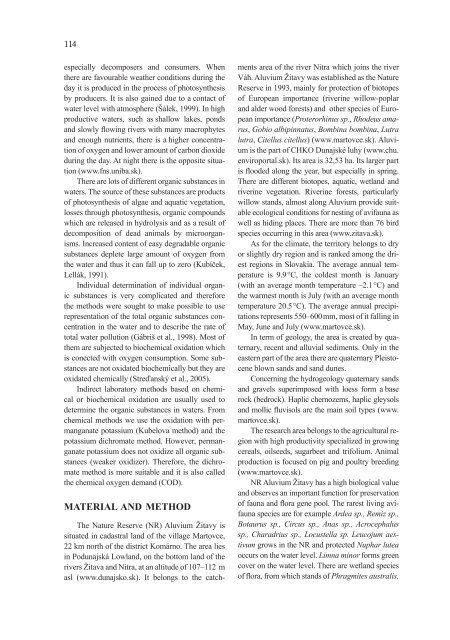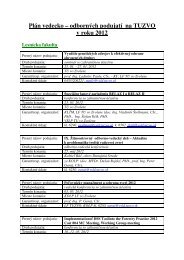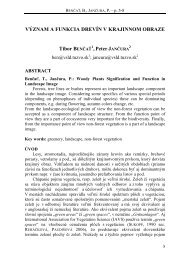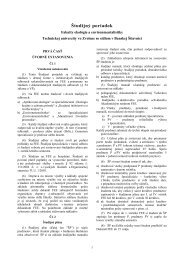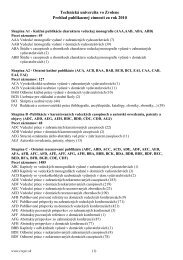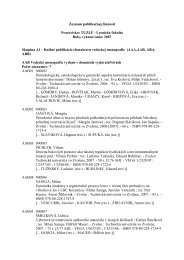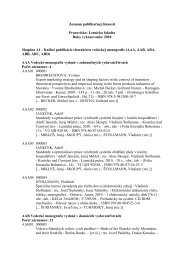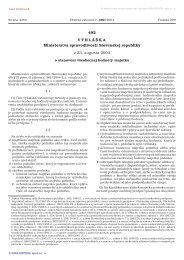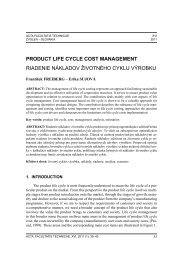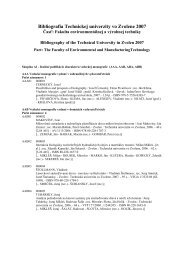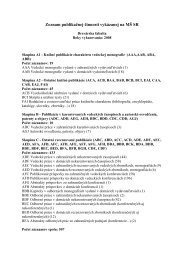Acta Facultatis Ecologiae - Technická univerzita vo Zvolene
Acta Facultatis Ecologiae - Technická univerzita vo Zvolene
Acta Facultatis Ecologiae - Technická univerzita vo Zvolene
- No tags were found...
Create successful ePaper yourself
Turn your PDF publications into a flip-book with our unique Google optimized e-Paper software.
114especially decomposers and consumers. Whenthere are fa<strong>vo</strong>urable weather conditions during theday it is produced in the process of photosynthesisby producers. It is also gained due to a contact ofwater level with atmosphere (Šálek, 1999). In highproductive waters, such as shallow lakes, pondsand slowly flowing rivers with many macrophytesand enough nutrients, there is a higher concentrationof oxygen and lower amount of carbon dioxideduring the day. At night there is the opposite situation(www.fns.uniba.sk).There are lots of different organic substances inwaters. The source of these substances are productsof photosynthesis of algae and aquatic vegetation,losses through photosynthesis, organic compoundswhich are released in hydrolysis and as a result ofdecomposition of dead animals by microorganisms.Increased content of easy degradable organicsubstances deplete large amount of oxygen fromthe water and thus it can fall up to zero (Kubíček,Lellák, 1991).Individual determination of individual organicsubstances is very complicated and thereforethe methods were sought to make possible to userepresentation of the total organic substances concentrationin the water and to describe the rate oftotal water pollution (Gábriš et al., 1998). Most ofthem are subjected to biochemical oxidation whichis conected with oxygen consumption. Some substancesare not oxidated biochemically but they areoxidated chemically (Streďanský et al., 2005).Indirect laboratory methods based on chemicalor biochemical oxidation are usually used todetermine the organic substances in waters. Fromchemical methods we use the oxidation with permanganatepotassium (Kubelova method) and thepotassium dichromate method. However, permanganatepotassium does not oxidize all organic substances(weaker oxidizer). Therefore, the dichromatemethod is more suitable and it is also calledthe chemical oxygen demand (COD).MATERIAL AND METHODThe Nature Reserve (NR) Aluvium Žitavy issituated in cadastral land of the village Martovce,22 km north of the district Komárno. The area liesin Podunajská Lowland, on the bottom land of therivers Žitava and Nitra, at an altitude of 107–112 masl (www.dunajsko.sk). It belongs to the catchmentsarea of the river Nitra which joins the riverVáh. Aluvium Žitavy was established as the NatureReserve in 1993, mainly for protection of biotopesof European importance (riverine willow-poplarand alder wood forests) and other species of Europeanimportance (Proterorhinus sp., Rhodeus amarus,Gobio albipinnatus, Bombina bombina, Lutralutra, Citellus citellus) (www.martovce.sk). Aluviumis the part of CHKO Dunajské luhy (www.chu.enviroportal.sk). Its area is 32,53 ha. Its larger partis flooded along the year, but especially in spring.There are different biotopes, aquatic, wetland andriverine vegetation. Riverine forests, particularlywillow stands, almost along Aluvium provide suitableecological conditions for nesting of avifauna aswell as hiding places. There are more than 76 birdspecies occurring in this area (www.zitava.sk).As for the climate, the territory belongs to dryor slightly dry region and is ranked among the driestregions in Slovakia. The average annual temperatureis 9.9 °C, the coldest month is January(with an average month temperature –2.1 °C) andthe warmest month is July (with an average monthtemperature 20.5 °C). The average annual precipitationsrepresents 550–600 mm, most of it falling inMay, June and July (www.martovce.sk).In term of geology, the area is created by quaternary,recent and alluvial sediments. Only in theeastern part of the area there are quaternary Pleistoceneblown sands and sand dunes.Concerning the hydrogeology quaternary sandsand gravels superimposed with loess form a baserock (bedrock). Haplic chernozems, haplic gleysolsand mollic fluvisols are the main soil types (www.martovce.sk).The research area belongs to the agricultural regionwith high productivity specialized in growingcereals, oilseeds, sugarbeet and trifolium. Animalproduction is focused on pig and poultry breeding(www.martovce.sk).NR Aluvium Žitavy has a high biological valueand observes an important function for preservationof fauna and flora gene pool. The rarest living avifaunaspecies are for example Ardea sp., Remiz sp.,Botaurus sp., Circus sp., Anas sp., Acrocephalussp., Charadrius sp., Locustella sp. Leucojum aestivumgrows in the NR and protected Nuphar luteaoccurs on the water level. Limna minor forms greencover on the water level. There are wetland speciesof flora, from which stands of Phragmites australis,


